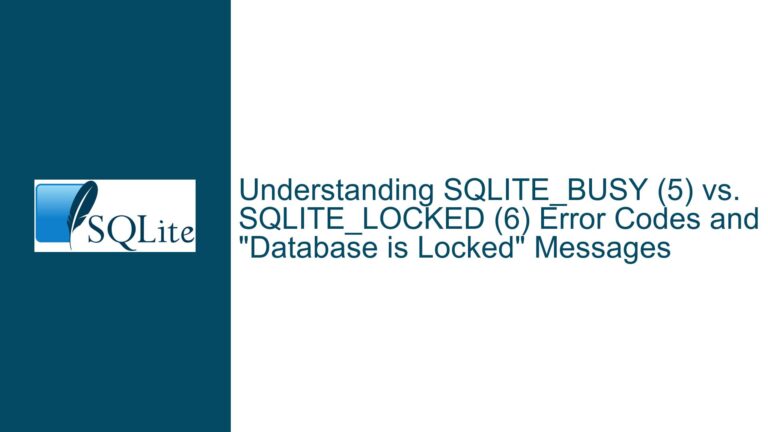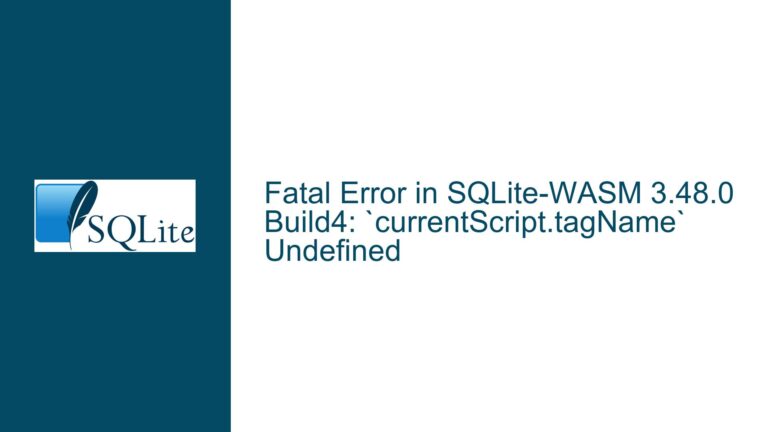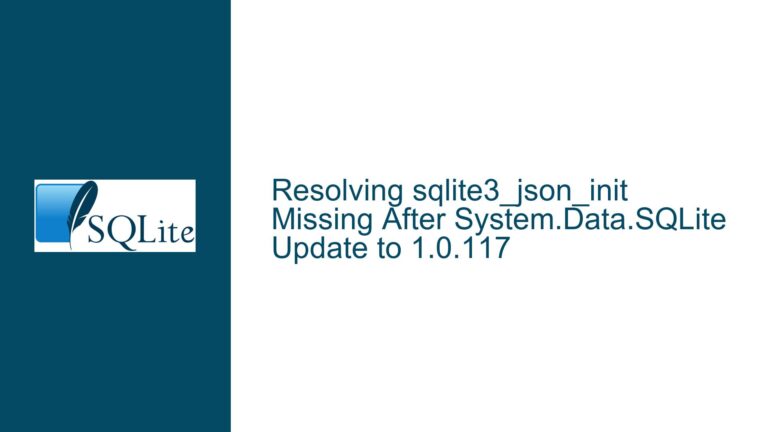SQLite Build System Migration: Issues, Causes, and Solutions
Issue Overview: Migration to Autosetup and Build System Challenges
The migration of SQLite’s build system from the traditional configure; make process to autosetup has introduced several challenges for developers and users who rely on custom build processes or specific configurations. The primary issues revolve around the following areas:
Incompatibility with Custom Build Processes: Developers who integrate SQLite into their own build systems, such as Python’s build system, face difficulties in extracting necessary configuration values like
-DHAVE_flags. These values are critical for ensuring that SQLite is compiled with the correct feature set for the target environment.Cross-Platform Build Issues: The new build system has introduced inconsistencies across different platforms, particularly in environments like Cygwin on Windows, where the build process fails due to missing rules or incorrect assumptions about the platform’s build tools. Additionally, the detection of dependencies like
readlineandTCLhas become less reliable, leading to build failures or incomplete builds.Extension Build Failures: Certain SQLite extensions, such as
lsm1and those in theext/miscdirectory, are not properly integrated into the new build system. This results in errors when attempting to build these extensions independently, as the necessary Makefile configurations are either missing or incomplete.ICU Dependency Configuration: The new build system relies on
icu-configfor configuring ICU (International Components for Unicode) dependencies, despiteicu-configbeing deprecated. This creates potential long-term maintenance issues and inconsistencies, as modern systems increasingly favorpkg-configfor dependency management.TCL Dependency Handling: The build system’s handling of TCL dependencies has become less robust, particularly when TCL is explicitly disabled (
--disable-tcl). This leads to errors during themake installphase, as the build system incorrectly assumes TCL-related variables likeTCLLIBDIRare always required.
Possible Causes: Underlying Factors Contributing to the Issues
Legacy Build System Assumptions: The migration to
autosetuphas exposed several assumptions made by the legacy build system that were not adequately addressed during the transition. For example, the legacy build system implicitly relied on certain environment variables or tools (likeicu-config) that are no longer universally available or recommended.Incomplete Feature Parity: While the new build system aims to replicate the functionality of the legacy system, certain features, such as the detection of
readlineandTCL, have not yet reached full parity. This is particularly evident in environments where these dependencies are installed in non-standard locations or require additional flags for proper linking.Platform-Specific Quirks: The new build system has not fully accounted for platform-specific quirks, such as the differences between GNU
makeand BSDmake, or the unique requirements of cross-compilation environments like Cygwin. These quirks often manifest as missing rules or incorrect tool invocations during the build process.Extension Build Isolation: The extensions in the
ext/lsm1andext/miscdirectories were not designed to be integrated into the main build system. As a result, they lack the necessary Makefile configurations to work seamlessly with the new build process. This isolation was intentional in the legacy system but has become a liability in the context of the new build system.Deprecated Dependency Tools: The continued reliance on deprecated tools like
icu-confighighlights a broader issue of dependency management in the new build system. Whilepkg-configis the modern standard for discovering and configuring dependencies, the build system has not yet fully embraced this approach, leading to inconsistencies and potential future maintenance challenges.
Troubleshooting Steps, Solutions & Fixes: Addressing the Build System Issues
Extracting Configuration Values for Custom Builds:
Developers who rely on custom build processes can use themake -pncommand to extract the necessary-DHAVE_flags from the generated Makefile. This approach is more reliable than parsing the Makefile directly, as it leverages GNUmake‘s internal database. For example:make -pn | grep -e '^SHELL_OPT'This command will output the compiler flags used during the build, which can then be incorporated into custom build scripts. For environments where GNU
makeis not available, alternative methods, such as usingbmake -V SHELL_OPTon BSD systems, can be employed.Resolving Cross-Platform Build Issues:
For Cygwin and other cross-compilation environments, ensure that the build system correctly identifies the platform’s requirements. This may involve manually editing the generated Makefile to remove incorrect.exesuffixes or adjusting the build rules to account for platform-specific toolchains. For example:grep '^[TB]\.exe' MakefileIf the output incorrectly includes
.exesuffixes, edit the Makefile to remove them. Additionally, ensure that the build system correctly detects dependencies likereadlineby providing explicit flags:./configure --with-readline-lib='-lreadline -lcurses' --with-readline-header=/usr/include/readline/readline.hFixing Extension Build Failures:
To build extensions likelsm1and those inext/misc, create a custom Makefile that integrates with the main build system. This Makefile should define the necessary rules for compiling and linking the extension, as well as any platform-specific flags. For example:CC = gcc CFLAGS = -fPIC -I../src LDFLAGS = -shared OBJS = lsm_ckpt.o lsm_file.o lsm_log.o lsm_main.o lsm_mem.o lsm_mutex.o lsm_shared.o lsm_sorted.o lsm_str.o lsm_tree.o lsm_unix.o lsm_win32.o lsm_varint.o lsm_vtab.o lsm.so: $(OBJS) $(CC) $(LDFLAGS) -o $@ $(OBJS) %.o: %.c $(CC) $(CFLAGS) -c $< -o $@This Makefile can be placed in the
ext/lsm1directory and invoked manually after running the mainconfigurescript.Modernizing ICU Dependency Configuration:
Replace the use oficu-configwithpkg-configfor discovering and configuring ICU dependencies. Update theauto.deffile to include a check forpkg-configand use it to retrieve the necessary flags. For example:if {[catch {exec pkg-config --exists icu-uc icu-i18n icu-io} err]} { puts "ICU not found via pkg-config, falling back to icu-config" set icu_flags [exec icu-config --ldflags-libsonly] } else { set icu_flags [exec pkg-config --libs icu-uc icu-i18n icu-io] }This approach ensures compatibility with modern systems while maintaining fallback support for environments where
icu-configis still available.Improving TCL Dependency Handling:
Modify the build system to handle TCL dependencies more robustly, particularly when TCL is explicitly disabled. Ensure that variables likeTCLLIBDIRare only required when TCL is enabled, and provide clear error messages when these variables are missing. For example:if {![get-define disable-tcl]} { if {![info exists TCLLIBDIR]} { error "TCLLIBDIR is not set. Please provide a valid TCL library directory or disable TCL support with --disable-tcl." } }This change will prevent build failures when TCL is disabled and improve the overall user experience.
By addressing these issues and implementing the suggested fixes, the SQLite build system can achieve greater stability and compatibility across a wide range of environments and use cases. The migration to autosetup represents a significant step forward, but it requires careful attention to detail and ongoing maintenance to ensure that it meets the needs of all users.






